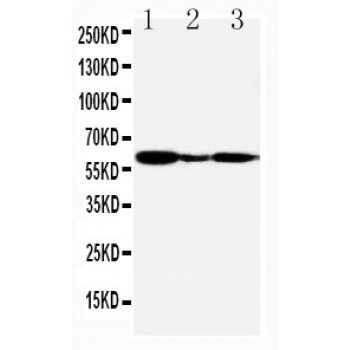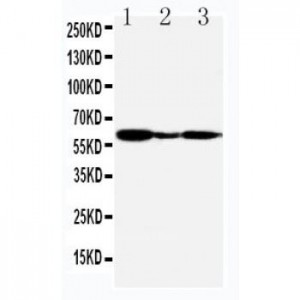More info
Overview
Long Name | Antibody Type | Antibody Isotype | Host | Species Reactivity | Validated Applications | Purification |
| G protein-coupled estrogen receptor 1 | Polyclonal | IgG | Rabbit | Human, Mouse, Rat | WB | Immunogen affinity purified. |
Immunogen | ||||||
| A synthetic peptide corresponding to a sequence at the C-terminus of human G-protein coupled receptor 30(275-288aa ENVFISVHLLQRTQ), different from the related mouse sequence by one amino acid, and from the related rat sequence by two amino acids. | ||||||
Properties
Form | Lyophilized |
Size | 100 µg/vial |
Contents | Antibody is lyophilized with 5 mg BSA, 0.9 mg NaCl, 0.2 mg Na2HPO4, 0.05 mg Thimerosal and 0.05 mg NaN3. *carrier free antibody available upon request. |
Concentration | Reconstitute with 0.2 mL sterile dH2O (500 µg/ml final concentration). |
Storage | At -20 °C for 12 months, as supplied. Store reconstituted antibody at 2-8 °C for one month. For long-term storage, aliquot and store at -20 °C. Avoid repeated freezing and thawing. |
Additional Information Regarding the Antigen
Gene | GPER1 |
Protein | G-protein coupled estrogen receptor 1 |
Uniprot ID | Q99527 |
Function | G-protein coupled estrogen receptor that binds to 17- beta-estradiol (E2) with high affinity, leading to rapid and transient activation of numerous intracellular signaling pathways. Stimulates cAMP production, calcium mobilization and tyrosine kinase Src inducing the release of heparin-bound epidermal growth factor (HB-EGF) and subsequent transactivation of the epidermal growth factor receptor (EGFR), activating downstream signaling pathways such as PI3K/Akt and ERK/MAPK. Mediates pleiotropic functions among others in the cardiovascular, endocrine, reproductive, immune and central nervous systems. Has a role in cardioprotection by reducing cardiac hypertrophy and perivascular fibrosis in a RAMP3-dependent manner. Regulates arterial blood pressure by stimulating vasodilation and reducing vascular smooth muscle and microvascular endothelial cell proliferation. Plays a role in blood glucose homeostasis contributing to the insulin secretion response by pancreatic beta cells. Triggers mitochondrial apoptosis during pachytene spermatocyte differentiation. Stimulates uterine epithelial cell proliferation. Enhances uterine contractility in response to oxytocin. Contributes to thymic atrophy by inducing apoptosis. Attenuates TNF-mediated endothelial expression of leukocyte adhesion molecules. Promotes neuritogenesis in developing hippocampal neurons. Plays a role in acute neuroprotection against NMDA- induced excitotoxic neuronal death. Increases firing activity and intracellular calcium oscillations in luteinizing hormone- releasing hormone (LHRH) neurons. Inhibits early osteoblast proliferation at growth plate during skeletal development. Inhibits mature adipocyte differentiation and lipid accumulation. Involved in the recruitment of beta-arrestin 2 ARRB2 at the plasma membrane in epithelial cells. Functions also as a receptor for aldosterone mediating rapid regulation of vascular contractibility through the PI3K/ERK signaling pathway. Involved in cancer progression regulation. Stimulates cancer-associated fibroblast (CAF) proliferation by a rapid genomic response through the EGFR/ERK transduction pathway. Associated with EGFR, may act as a transcription factor activating growth regulatory genes (c-fos, cyclin D1). Promotes integrin alpha-5/beta-1 and fibronectin (FN) matrix assembly in breast cancer cells. |
Tissue Specificity | Expressed in placenta, endothelial and epithelial cells, non laboring and laboring term myometrium, fibroblasts and cancer-associated fibroblasts (CAF), prostate cancer cells and invasive adenocarcinoma (at protein level). Ubiquitously expressed, but is most abundant in placenta. In brain regions, expressed as a 2.8 kb transcript in basal forebrain, frontal cortex, thalamus, hippocampus, caudate and putamen. |
Sub-cellular localization | Nucleus. Cytoplasm . Cytoplasm, perinuclear region. Cytoplasm, cytoskeleton. Cell membrane; Multi- pass membrane protein. Basolateral cell membrane; Multi-pass membrane protein. Cytoplasmic vesicle membrane; Multi-pass membrane protein. Early endosome. Recycling endosome. Golgi apparatus membrane ; Multi-pass membrane protein . Golgi apparatus, trans-Golgi network. Endoplasmic reticulum membrane; Multi-pass membrane protein. Cell projection, dendrite . Cell projection, dendritic spine membrane ; Multi-pass membrane protein . Cell projection, axon . Cell junction, synapse, postsynaptic cell membrane, postsynaptic density . Mitochondrion membrane ; Multi-pass membrane protein . Note: Colocalized with BSN to the active zone of presynaptic density. Colocalized with DLG4/PSD95 and neurabin-2 PPP1R9B in neuronal synaptosomes (By similarity). Endocytosed in a agonist- and arrestin-independent manner. Colocalized with RAMP3 and clathrin-coated pits at the plasma membrane. Colocalized with transferrin receptor at the plasma membrane and perinuclear region. Accumulated and colocalized with RAB11 proteins in recycling endosomes and trans-Golgi network (TGN), but does neither recycle back to the cell surface nor traffics to late endosome or lysosome. Colocalized with calnexin in the endoplasmic reticulum. Traffics to intracellular sites via cytokeratin intermediate filaments like KRT7 and KRT8 after constitutive endocytosis in epithelial cells. Colocalized with EGFR in the nucleus of agonist-induced cancer-associated fibroblasts (CAF). |
Sequence Similarities | Belongs to the G-protein coupled receptor 1 family. |
Aliases | CEPR antibody|Chemoattractant receptor-like 2 antibody|Chemokine receptor-like 2 antibody|CMKRL2 antibody|FEG-1 antibody|Flow-induced endothelial G protein-coupled receptor antibody|Flow-induced endothelial G-protein coupled receptor 1 antibody|G protein-coupled receptor 30 antibody|G-protein coupled estrogen receptor 1 antibody|G-protein coupled receptor 30 antibody|GPCR-Br antibody|Gper antibody|GPER_HUMAN antibody|GPR30 antibody|IL8-related receptor DRY12 antibody|Lergu antibody|LERGU2 antibody|leucine rich protein in GPR30 3'UTR antibody|LYGPR antibody|Lymphocyte-derived G-protein coupled receptor antibody|Membrane estrogen receptor antibody|mER antibody|MGC99678 antibody |
Application Details
| Application | Concentration* | Species | Validated Using** |
| Western blot | 0.1-0.5μg/ml | Human Mouse, Rat | AssaySolutio's ECL kit |
AssaySolution recommends Rabbit Chemiluminescent WB Detection Kit (AKIT001B) for Western blot. *Blocking peptide can be purchased at $65. Contact us for more information

Anti-G-protein coupled receptor 30 antibody, ASA-B0744, Western blotting
Lane 1: COLO320 Cell Lysate
Lane 2: MCF-7 Cell Lysate
Lane 3: COS7 Cell Lysate
Lane 1: COLO320 Cell Lysate
Lane 2: MCF-7 Cell Lysate
Lane 3: COS7 Cell Lysate



